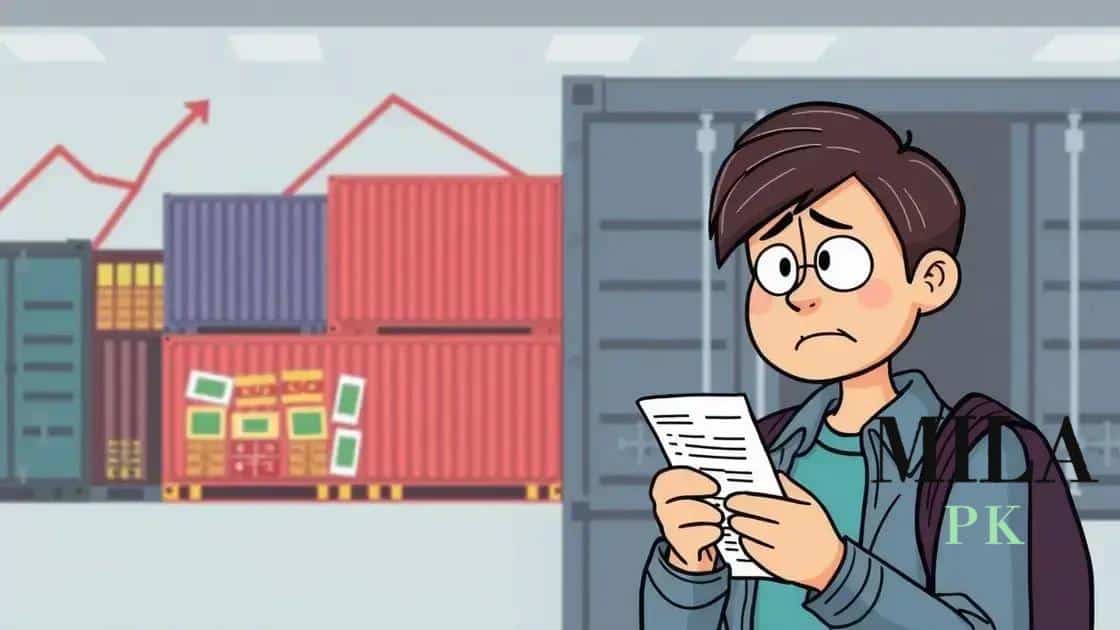Tariff increases linked to rising import inflation

Tariff increases linked to rising import inflation lead to higher consumer prices and significant changes for businesses, making it crucial to adopt effective budgeting and strategic sourcing to mitigate impacts.
Tariff increases linked to rising import inflation are causing a stir in economic circles. Have you felt the pinch at the checkout? In this article, we’ll dive into how these tariffs impact your everyday expenses.
Understanding tariff increases
Understanding tariff increases is crucial for anyone looking to navigate the complexities of today’s economy. These increases can significantly affect the prices of goods we buy every day. They are often implemented by governments to protect domestic industries or raise revenue, but at what cost to consumers?
What are Tariff Increases?
When a government raises tariffs, it imposes a tax on imported goods. This means that imports become more expensive for consumers and businesses. As a result, domestic producers can raise their prices because they face less competition. However, this can lead to a cycle of inflation as consumers start paying more for items they need.
Reasons Behind Tariff Increases
There are several reasons why governments impose tariff increases. Some of the most common reasons include:
- Protecting local jobs from foreign competition.
- Responding to trade imbalances.
- Generating revenue for government spending.
- Encouraging local production and consumption.
While these reasons may seem beneficial at first glance, the reality is more complex. For example, local jobs might be protected, but consumers may end up paying more for the same products.
Additionally, tariff increases can lead to retaliation from other countries. This cycle of tit-for-tat tariffs can escalate quickly, resulting in increased costs for everyone involved. As you can see, the implications of these increases touch various aspects of the economy.
The Impact on Consumers
In the end, the biggest question is how tariff increases affect you. As prices rise, your purchasing power diminishes, meaning you may have to cut back on non-essential items. This scenario can lead to decreased consumer spending, potentially slowing down the entire economy.
Awareness and understanding of these tariff increases are essential for making informed decisions about spending and saving. As prices change, it’s good to stay updated on economic trends, especially if you are a consumer trying to budget your expenses.
The role of import inflation

The role of import inflation is a critical piece in understanding the financial landscape. Import inflation occurs when the cost of goods from abroad rises, pushing prices higher for consumers locally.
How Import Inflation Affects Prices
As import inflation rises, it can squeeze household budgets. Imported products become more expensive, resulting in higher retail prices across various sectors. This often leads consumers to make difficult choices about spending.
Main Contributors to Import Inflation
Several factors contribute to import inflation, including:
- Exchange rate fluctuations that make foreign goods more costly.
- Increased transportation costs due to higher fuel prices.
- Global supply chain disruptions that limit product availability.
- Changes in trade policies that impact import costs.
Each of these factors can create a cascading effect, where the rising costs of imports lead to inflationary pressures in the local economy.
It’s essential to stay aware of how import inflation can influence your daily life. For instance, rising food prices can strain family budgets, while higher costs for electronics may drive consumers to delay purchases.
Long-term Effects of Import Inflation
While some price increases may be temporary, prolonged import inflation can have lasting impacts. Consumers may alter their buying habits, choosing cheaper or domestic alternatives instead. Businesses might respond by adjusting their pricing strategies, which can also reshape the market.
Thoroughly understanding the role of import inflation helps in making informed financial decisions. Staying informed about economic trends is crucial for managing resources effectively.
Impact on consumers and businesses
The impact of tariff increases on consumers and businesses is profound. As tariffs rise, prices for imported goods can climb, affecting everyone in the economy. When consumers face higher prices, their purchasing power decreases, leading to changes in spending habits.
Effects on Consumers
For consumers, higher tariffs often mean paying more for essential items. Everyday goods, like food and electronics, can experience price hikes. This creates challenges when people try to manage their budgets. Consequently, many families may cut back on non-essential purchases.
Effects on Businesses
Businesses also feel the effects of tariff increases. Higher costs for imported materials can squeeze profit margins. This may lead businesses to:
- Increase prices for consumers to maintain profits.
- Look for cheaper alternatives, possibly sacrificing quality.
- Reduce workforce or halt expansion plans.
- Change sourcing strategies by opting for domestic suppliers.
These decisions can impact not only profitability but also job stability. If businesses struggle, it can lead to layoffs and decreased economic growth in the community.
Moreover, small businesses may find it harder to absorb these costs compared to larger corporations. They often operate on thinner margins and may have limited resources to adapt quickly.
The Ripple Effect
The ripple effect of tariff increases means that both consumers and businesses must adapt to these changes. As prices rise, consumer confidence can wane, which may lead to lower overall demand. This could slow down economic growth and prolong recovery during economic downturns.
Understanding the impact of tariffs can prepare both consumers and businesses for the uncertainties ahead. It’s essential to stay informed and proactive in managing how these economic changes influence everyday life.
Strategies to manage rising costs
Managing rising costs in today’s economy can be challenging for both consumers and businesses. As tariff increases and import inflation put pressure on prices, it’s essential to implement effective strategies to cope.
Budgeting Wisely
One of the first steps consumers can take is to create a budget. This helps track spending and identify where to cut back. Simple adjustments can make a big difference. For example:
- Reduce discretionary spending on non-essentials.
- Prioritize necessary expenses such as food and housing.
- Look for sales and discounts to save money on regular purchases.
By being more mindful of spending, consumers can navigate rising costs without sacrificing their quality of life.
Businesses Adapting to Change
For businesses, adapting to rising costs requires strategic planning. Here are some approaches they can consider:
- Negotiate with suppliers for better rates or bulk discounts.
- Optimize supply chains to reduce transportation costs.
- Invest in technology to improve efficiency and reduce waste.
These strategies help businesses maintain profitability while managing the increase in costs. Flexible planning can also allow companies to pivot in response to market changes.
Another effective tactic is to focus on customer loyalty. Offering rewards or discounts to repeat customers can ensure steady sales even when prices rise. Retaining loyal customers is often more cost-effective than attracting new ones.
Consider Alternative Solutions
Consumers and businesses alike should explore alternative solutions to cope with rising prices. Seeking local products can minimize costs associated with imports. Support for local businesses not only helps the economy but can also lead to fresher products at lower prices.
Additionally, staying informed about economic trends can empower consumers and businesses to react proactively to price shifts. Knowledge is key in making smart financial decisions.
Future trends in tariffs and inflation
Understanding future trends in tariffs and inflation is essential for consumers and businesses alike. These trends can shape the economic landscape and impact daily life.
Predicted Changes in Tariffs
Experts predict that tariffs may continue to fluctuate based on global trade relations. As countries negotiate trade agreements, they might lower or raise tariffs to protect domestic industries. This could lead to more competition among businesses, affecting prices and availability of goods.
The Impact of Inflation Rates
Inflation rates are also likely to trend upwards in response to various factors, including:
- Increasing demand for goods and services as economies recover.
- Supply chain disruptions that tighten supply lines.
- Rising costs for raw materials affecting production.
- Changes in consumer behavior due to external economic pressures.
These elements can combine to create persistent inflation, which can trickle down to affect consumer prices extensively.
Future Economic Policies
Governments may implement different economic policies to manage tariffs and inflation. These could include measures to:
- Stabilize prices by adjusting interest rates.
- Invest in domestic production to reduce reliance on imports.
- Encourage innovation to improve supply chain efficiency.
By fostering a more balanced economy, governments may help mitigate some effects of rising costs for consumers.
Staying aware of these trends allows individuals and businesses to prepare for potential changes, leading to smarter financial decisions. Being informed can help navigate the uncertainties related to tariffs and inflation in the future.
FAQ – Frequently Asked Questions about Tariff Increases and Inflation
How do tariff increases affect consumer prices?
Tariff increases make imported goods more expensive, leading to higher prices for everyday items, impacting household budgets.
What strategies can businesses use to cope with rising costs?
Businesses can negotiate with suppliers, optimize supply chains, and focus on customer loyalty to manage the impact of rising costs.
What is import inflation?
Import inflation occurs when the cost of imported goods increases, driving prices up for consumers and affecting overall economic conditions.
How can consumers prepare for future economic trends?
Consumers can stay informed about economic news, adjust their budgets, and consider local products to mitigate the effects of rising costs.





